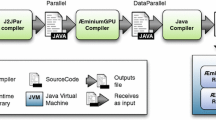Abstract
Performance of a program depends on two factors: better hardware of the executing machine and exploiting parallelism for concurrent execution. Loops with multiple iterations provide efficient parallelism in an application, and are used to reduce overall execution time and also to increase performance. Abstract Syntax Tree (AST) can be used as an effective tool for exploiting parallelism at the compiler level. This definitely saves time and automates the decomposition of a parallel job that is to be executed in parallel framework. AST can be used to detect loops in the source code, therefore this approach can be used to design a new parallel computing framework where simple codes written for normal machines can be parallelized by the framework itself.
Access this chapter
Tax calculation will be finalised at checkout
Purchases are for personal use only
Similar content being viewed by others
References
Parhami, B. (2002). Introduction to parallelism. Introduction to parallel processing: Algorithms and architectures (pp. 3–23).
https://en.wikipedia.org/wiki/Instruction-level_parallelism.
Lilja, D. J. (1994). Exploiting the parallelism available in loops. Computer, 27(2), 13–26.
Kumar, R., & Singh, P. K. (2014). An approach for compiler optimization to exploit instruction level parallelism. In Advanced Computing, Networking and Informatics (Vol. 2, pp. 509–516). Cham: Springer.
Rau, B. R., & Fisher, J. A. (2003). Instruction-level parallelism.
Lo, J. L., Emer, J. S., Levy, H. M., Stamm, R. L., Tullsen, D. M., & Eggers, S. J. (1997). Converting thread-level parallelism to instruction-level parallelism via simultaneous multithreading. ACM Transactions on Computer Systems (TOCS), 15(3), 322–354.
http://www2.phys.canterbury.ac.nz/dept/docs/manuals/FORTRAN.
https://cloud.google.com/dataflow/examples/wordcount-example.
Zhong, H., Mehrara, M., Lieberman, S., & Mahlke, S. (2008, February). Uncovering hidden loop level parallelism in sequential applications. In IEEE 14th International Symposium on High Performance Computer Architecture, 2008. HPCA 2008 (pp. 290–301). IEEE.
Tullsen, D. M., Eggers, S. J., & Levy, H. M. (1995, June). Simultaneous multithreading: Maximizing on-chip parallelism. In 22nd Annual International Symposium on Computer Architecture, 1995. Proceedings (pp. 392–403). IEEE.
Wall, D. W. (1991). Limits of instruction-level parallelism (Vol. 19, No. 2, pp. 176–188). ACM.
Larsen, S., & Amarasinghe, S. (2000). Exploiting superword level parallelism with multimedia instruction sets (Vol. 35, No. 5, pp. 145–156). ACM.
Quarteroni, A., & Valli, A. (1996). Domain decomposition methods for partial differential equations.
Johnson, T. A., Eigenmann, R., & Vijaykumar, T. N. (2007, March). Speculative thread decomposition through empirical optimization. In Proceedings of the 12th ACM SIGPLAN Symposium on Principles and Practice of Parallel Programming (pp. 205–214). ACM.
Jackins, C. L., & Tanimoto, S. L. (1983). Quad-trees, Oct-trees, and K-trees: A generalized approach to recursive decomposition of euclidean space. IEEE Transactions on Pattern Analysis and Machine Intelligence, 5, 533–539.
Stone, R. B., & Wood, K. L. (2000). Development of a functional basis for design. Journal of Mechanical Design, 122(4), 359–370.
Arabnia, H. R. (1990). A parallel algorithm for the arbitrary rotation of digitized images using process-and-data-decomposition approach. Journal of Parallel and Distributed Computing, 10(2), 188–192.
Jojic, V., Gould, S., & Koller, D. (2010, June). Accelerated dual decomposition for MAP inference. In ICML (pp. 503–510).
Devaurs, D., Siméon, T., & Cortés, J. (2013). Parallelizing RRT on large-scale distributed-memory architectures. IEEE Transactions on Robotics, 29(2), 571–579.
Neamtiu, I., Foster, J. S., & Hicks, M. (2005). Understanding source code evolution using abstract syntax tree matching. ACM SIGSOFT Software Engineering Notes, 30(4), 1–5.
Dinh, Q. T., Necoara, I., & Diehl, M. (2014). Path-following gradient-based decomposition algorithms for separable convex optimization. Journal of Global Optimization, 59(1), 59–80.
https://web.stanford.edu/class/ee364b/lectures/decomposition_slides.pdf linear algebra with applications 7.7-8 (2000), 687–714.
Pfenning, F., & Elliott, C. (1988, June). Higher-order abstract syntax. In ACM SIGPLAN Notices (Vol. 23, No. 7, pp. 199–208). ACM.
Fiore, M., Plotkin, G., & Turi, D. (1999). Abstract syntax and variable binding. In 14th Symposium on Logic in Computer Science, 1999. Proceedings (pp. 193–202). IEEE.
Wile, D. S. (1997, May). Abstract syntax from concrete syntax. In Proceedings of the 19th International Conference on Software Engineering (pp. 472–480). ACM.
Lim, A. W., & Lam, M. S. (1997, January). Maximizing parallelism and minimizing synchronization with affine transforms. In Proceedings of the 24th ACM SIGPLAN-SIGACT Symposium on Principles of Programming Languages (pp. 201–214). ACM.
Author information
Authors and Affiliations
Corresponding author
Editor information
Editors and Affiliations
Rights and permissions
Copyright information
© 2019 Springer Nature Singapore Pte Ltd.
About this paper
Cite this paper
Kumar, A., Singh, H. (2019). Exploiting Parallelism Available in Loops Using Abstract Syntax Tree. In: Shetty, N., Patnaik, L., Nagaraj, H., Hamsavath, P., Nalini, N. (eds) Emerging Research in Computing, Information, Communication and Applications. Advances in Intelligent Systems and Computing, vol 882. Springer, Singapore. https://doi.org/10.1007/978-981-13-5953-8_47
Download citation
DOI: https://doi.org/10.1007/978-981-13-5953-8_47
Published:
Publisher Name: Springer, Singapore
Print ISBN: 978-981-13-5952-1
Online ISBN: 978-981-13-5953-8
eBook Packages: EngineeringEngineering (R0)




